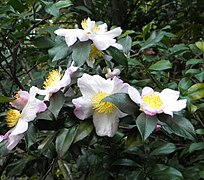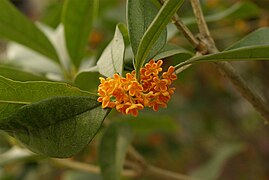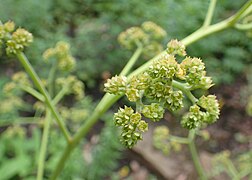Geranylprimverosid
| Strukturformel | |||||||||||||
|---|---|---|---|---|---|---|---|---|---|---|---|---|---|

| |||||||||||||
| Allgemeines | |||||||||||||
| Name | Geranylprimverosid | ||||||||||||
| Summenformel | C21H36O10 | ||||||||||||
| Externe Identifikatoren/Datenbanken | |||||||||||||
| |||||||||||||
| Eigenschaften | |||||||||||||
| Molare Masse | 448,5 g·mol−1 | ||||||||||||
| Sicherheitshinweise | |||||||||||||
| |||||||||||||
| Soweit möglich und gebräuchlich, werden SI-Einheiten verwendet. Wenn nicht anders vermerkt, gelten die angegebenen Daten bei Standardbedingungen (0 °C, 1000 hPa). | |||||||||||||
Geranylprimverosid ist ein natürlich vorkommendes Glycosid aus β-D-Primverose und Geraniol.
Vorkommen
[Bearbeiten | Quelltext bearbeiten]Geranylprimverosid ist neben Benzylprimverosid, Phenethylprimverosid, Linalylprimverosid und (Z)-3-Hexenolprimverosid Bestandteil des Aromas von Tee.[2][3][4] Daneben kommt es auch in Pomelo[5], Trauben[6], sowie der Süßen Duftblüte (Osmanthum fragrans)[7] und dem Holunderblättrigen Schaublatt (Gattung Rodgersia)[8] vor.
-
Teepflanze
-
Pomelo
-
Trauben
-
Süße Duftblüte
-
Holunderblättriges Schaublatt
Biosynthese
[Bearbeiten | Quelltext bearbeiten]Die Biosynthese in Teepflanzen wurde untersucht. Dabei findet eine zweistufige Glycosylierung statt, zuerst mit Glucose, dann mit Xylose. Eine Glycosyltransferase bildet Glucoside von verschiedenen Alkoholen (neben Geraniol auch 2-Phenylethanol, Linalool und Benzylalkohol). Eine zweite kann dann spezifisch diese Glucoside durch Übertragung von Xylose in Primveroside überführen.[4]
Synthese
[Bearbeiten | Quelltext bearbeiten]Mittels Umglycosylierung des Primverosids von p-Nitrophenol mittels Penicillium multicolor können diverse andere Primveroside, darunter auch Geranylprimverosid im Millimol-Maßstab hergestellt werden. Im Gegensatz zu anderen Alkoholen (z. B. Benzylalkohol oder 2-Phenylethanol) ist die Ausbeute mit Geraniol aber eher gering (8–12 %).[9]
Einzelnachweise
[Bearbeiten | Quelltext bearbeiten]- ↑ Dieser Stoff wurde in Bezug auf seine Gefährlichkeit entweder noch nicht eingestuft oder eine verlässliche und zitierfähige Quelle hierzu wurde noch nicht gefunden.
- ↑ Dongmei Wang, Eriko Kurasawa, Yuichi Yamaguchi, Kikue Kubota, Akio Kobayashi: Analysis of Glycosidically Bound Aroma Precursors in Tea Leaves. 2. Changes in Glycoside Contents and Glycosidase Activities in Tea Leaves during the Black Tea Manufacturing Process. In: Journal of Agricultural and Food Chemistry. Band 49, Nr. 4, 1. April 2001, S. 1900–1903, doi:10.1021/jf001077+.
- ↑ Dongmei Wang, Takako Yoshimura, Kikue Kubota, Akio Kobayashi: Analysis of Glycosidically Bound Aroma Precursors in Tea Leaves. 1. Qualitative and Quantitative Analyses of Glycosides with Aglycons as Aroma Compounds. In: Journal of Agricultural and Food Chemistry. Band 48, Nr. 11, 1. November 2000, S. 5411–5418, doi:10.1021/jf000443m.
- ↑ a b Shoji Ohgami, Eiichiro Ono, Manabu Horikawa, Jun Murata, Koujirou Totsuka, Hiromi Toyonaga, Yukie Ohba, Hideo Dohra, Tatsuo Asai, Kenji Matsui, Masaharu Mizutani, Naoharu Watanabe, Toshiyuki Ohnishi: Volatile Glycosylation in Tea Plants: Sequential Glycosylations for the Biosynthesis of Aroma β -Primeverosides Are Catalyzed by Two Camellia sinensis Glycosyltransferases. In: Plant Physiology. Band 168, Nr. 2, Juni 2015, S. 464–477, doi:10.1104/pp.15.00403, PMID 25922059, PMC 4453793 (freier Volltext).
- ↑ Desen Su, Yunyun Zheng, Ziqiang Chen, Yuwu Chi: Simultaneous determination of six glycosidic aroma precursors in pomelo by ultra-high performance liquid chromatography-tandem mass spectrometry. In: The Analyst. Band 146, Nr. 5, 2021, S. 1698–1704, doi:10.1039/D0AN01705A.
- ↑ Michele D’Ambrosio: Advances in the Dereplication of Aroma Precursors from Grape Juice by Pretreatment with Lead Acetate and Combined HILIC- and RP-HPLC Methods. In: Foods. Band 8, Nr. 1, 15. Januar 2019, S. 28, doi:10.3390/foods8010028, PMID 30650665, PMC 6351915 (freier Volltext).
- ↑ Jiang Liu, Seikou Nakamura, Bin Xu, Takahiro Matsumoto, Tomoe Ohta, Katsuyoshi Fujimoto, Keiko Ogawa, Masashi Fukaya, Shiori Miyake, Masayuki Yoshikawa, Hisashi Matsuda: Chemical structures of constituents from the flowers of Osmanthus fragrans var. aurantiacus. In: Journal of Natural Medicines. Band 69, Nr. 1, Januar 2015, S. 135–141, doi:10.1007/s11418-014-0869-1.
- ↑ Hao-Bin Hu, Yu-Feng Jian, Hong Cao, Xu-Dong Zheng: Chemical Constituents from the Root Bark of Rodgersia Sambucifolia. In: Journal of the Chinese Chemical Society. Band 54, Nr. 1, Februar 2007, S. 75–80, doi:10.1002/jccs.200700013.
- ↑ Kazutaka Tsuruhami, Shigeharu Mori, Kanzo Sakata, Satoshi Amarume, Shigetaka Saruwatari, Takeomi Murata, Taichi Usui: Efficient Synthesis of β‐Primeverosides as Aroma Precursors by Transglycosylation of β‐Diglycosidase from Penicillium multicolor. In: Journal of Carbohydrate Chemistry. Band 24, Nr. 8-9, 1. November 2005, S. 849–863, doi:10.1080/07328300500439413.




